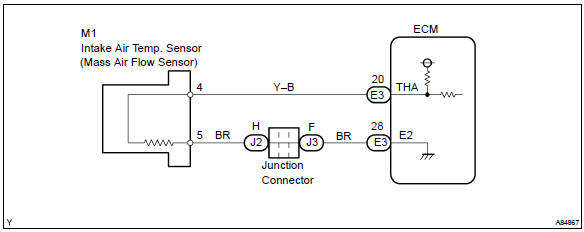Toyota Corolla (E120) 2002–2008 Repair Manual / Diagnostics / Sfi system / Intake air temperature circuit / Circuit description
Toyota Corolla (E120): Circuit description

The intake air temperature (iat) sensor, mounted on the mass air flow (maf) sensor, monitors the intake air temperature. The iat sensor has a thermistor that varies its resistance depending on the temperature of the intake air. When the air temperature is low, the resistance in the thermistor increases. When the temperature is high, the resistance drops. The variations in resistance are reflected as voltage changes to the ecm terminal.
(See fig. 1).
The intake air temperature sensor is connected to the ecm.
The 5 v power source voltage in the ecm is applied to the intake air temperature sensor from terminal tha (thar) via resistor r.
That is, the resistor r and the intake air temperature sensor are connected in series. When the resistance value of the intake air temperature sensor changes in accordance with changes in the intake air temperature, the potential at terminal tha (thar) also changes. Based on this signal, the ecm increases the fuel injection volume to improve the drive ability during cold engine operation.
|
Dtc no. |
Proceed to |
Dtc detection condition |
Trouble area |
| P0110 | Step 1 | Open or short in intake air temperature sensor circuit for 0.5 Seconds |
|
| P0112 | Step 4 | Short in intake air temperature sensor circuit for 0.5 Seconds | |
| P0113 | Step 2 | Open in intake air temperature sensor circuit for 0.5 Seconds |
Hint
: after confirming dtc p0110, p0112 or p0113, confirm the intake air temperature in the ”diagnosis / enhanced obd ii / data list / all” using the hand–held tester or the obd ii scan tool.

Monitor description
The ecm monitors the sensor voltage and uses this value to calculate the intake air temperature. When the sensor output voltage deviates from the normal operating range, the ecm interprets this as a fault in the iat sensor and sets a dtc.
Example: when the sensor voltage output equal to –40 c (–40 °F) or more than 140 c (284 °F).
Monitor strategy

Typical enabling conditions

Typical malfunction thresholds

Component operating range

Wiring diagram

Other materials:
Taking out the spare tire
1 Remove the luggage floor cover.
2 Remove the tool tray.
3 Loosen the center fastener that secures the spare tire.
CAUTION
■When storing the spare tire
Be careful not to catch fingers or other body parts between the spare tire and
the body of the vehicle. ...
Front suspension arm sub–assy lower no.1 Lh
Replacement
Hint: components:
1. Remove front wheel
2. Disconnect front stabilizer link assy lh (lh (a/t) position)
3. Disconnect front stabilizer link assy rh (lh (a/t) position)
Hint:
remove the rh side by the same procedures as the lh side.
4. Separate front suspension arm sub–assy lowe ...
Cruise control
The vehicle can be driven at
a set speed even if the
accelerator pedal is not
depressed.
Use the cruise control only
on highways and expressways.
WARNING
■For safe use
Driving safely is solely the
responsibility of the driver.
Therefore, do not overly rely on
this system. The driver is solel ...


